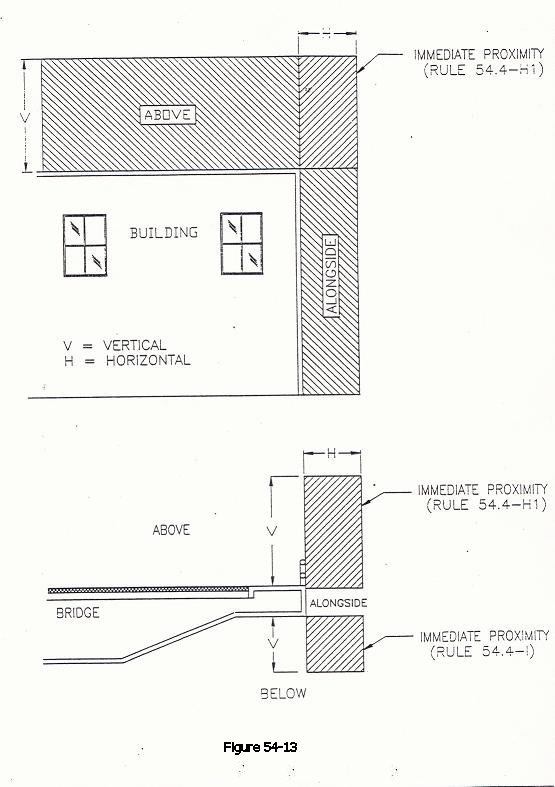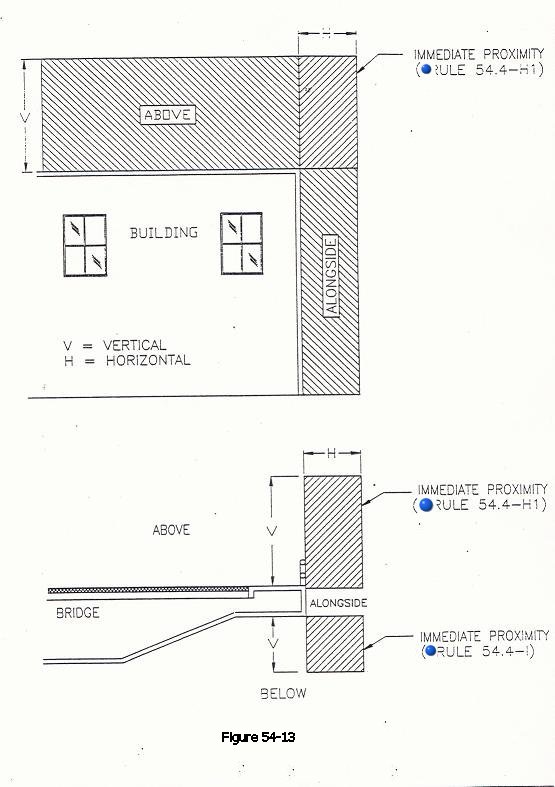
Original Version
Rule 54.4-H1
54.4-H1)
Unattached Conductors: Conductors should
be arranged so as not to hamper or endanger workers and firefighters while
performing their duties. The basic
clearances of conductors from buildings are specified in Table 1, Cases 6 and
7. The horizontal clearance (Table 1,
Case 7) shall be maintained until the vertical clearance (Table 1, Case 6) is
attained (see Fig. 54-13). The
horizontal clearance The requirements
of Table 1, Cases 7 also apply at fire escapes, exits, windows, etc., at which
human contact may be reasonably expected.
|Where the vertical distance above
ground of conductors of 7500 volts less is in excess of 35 feet, the horizontal
clearances front eh buildings may be less than 6 feet (Table 1, Case 7, Column
E) but shall be not less than 4 feet.
See Rule 54.8-B4 for service drop clearance requirements.
For special treatment
of bus and lead wires of transformer installations in alleys, etc., see rules
58.3-B2.

Strikeout and Underline Version
Rule 54.4-H1
54.4-H1)
Unattached Conductors: Conductors should
be arranged so as not to hamper or endanger workers and firefighters while
performing their duties. The basic
clearances of conductors from buildings are specified in Table 1, Cases 6 and
7. The horizontal clearance (Table 1,
Case 7) shall be maintained until the vertical clearance (Table 1, Case 6) is
attained (see Fig. 54-13). The
horizontal clearance The requirements
of Table 1, Cases 7 also apply at fire escapes, exits, windows, etc., at which
human contact may be reasonably expected.
Where the vertical distance
above ground of conductors of 7500 volts less is in excess of 35 feet, the
horizontal clearances front eh buildings may be less than 6 feet (Table 1, Case
7, Column E) but shall be not less than 4 feet. See Rule 54.8-B4 for service drop clearance requirements.For special
treatment of bus and lead wires of transformer installations in alleys, etc.,
see rules 58.3-B2.
EXCEPTION: The horizontal conductor clearance from buildings may be reduced from 6 feet to 4 feet ( Table 1, Case 7, Column E ) if all of the following criteria are met:
a) The conductor voltage is 7,500 volts or less; and
b) The conductor vertical clearance above ground is more than 35 feet; and
c) The building height next to the conductors exceeds the conductor height by 6 feet or more; and
d) There are no fire escapes, exits, or windows at which human contact may be reasonably expected.
Note: See Rule 54.8–B4 for service drop clearance requirements and Table 58–1 for special treatment of bus and lead wires of transformer installations in alleys.

Final Version
Rule 54.4-H1
54.4-H1) Unattached Conductors: Conductors should be arranged so as not to hamper or endanger workers and firefighters while performing their duties. The basic clearances of conductors from buildings are specified in Table 1, Cases 6 and 7. The horizontal clearance (Table 1, Case 7) shall be maintained until the vertical clearance (Table 1, Case 6) is attained (see Fig. 54-13). The horizontal clearance The requirements of Table 1, Cases 7 also apply at fire escapes, exits, windows, etc., at which human contact may be reasonably expected.
EXCEPTION: The horizontal conductor clearance from buildings may be reduced from 6 feet to 4 feet ( Table 1, Case 7, Column E ) if all of the following criteria are met:
a) The conductor voltage is 7,500 volts or less; and
b) The conductor vertical clearance above ground is more than 35 feet; and
c) The building height next to the conductors exceeds the conductor height by 6 feet or more; and
d) There are no fire escapes, exits, or windows at which human contact may be reasonably expected.
Note: See Rule 54.8–B4 for service drop clearance requirements and Table 58–1 for special treatment of bus and lead wires of transformer installations in alleys.
